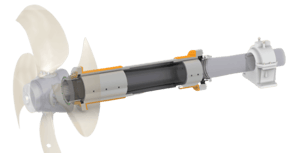Many years ago there was a mechanical and civil engineer named Isambard Kingdom Brunel. In 1843 he designed the first iron built ocean going ship, the SS Great Britain, which used a propeller instead of paddle wheels to propel the ship forward. This was also the first vessel that used a stern tube which was closed off with a simple stuffing box.
Nowadays many know that a vessel uses a propeller, located at the aft peak of the ship, to propel the vessel forward and surprisingly often we speak to people wondering how the connection is made between the propeller and the main engine. This blog explains in a simple way how some of the parts of the propulsion line are connected and where they are used for.
The stern tube
Like the name suggests, the stern tube is a hollow tube which accommodates the bearings, the seal boxes and the propeller shaft. The stern tube is filled with either oil, grease or water and forms a barrier between the water outside and the engine room inside the vessel.
The stern tube mainly consists of the following parts: the tube itself, connection flanges (forward and aft), bearings (forward and aft), smaller pipes for temperature sensors, lubrication of the aft seal and/or drain pipes for air type seals (Supreme Ventus® or Supreme Athmos®) and of course the forward seal (engine room side) and aft(er) seal (water side).
The bearings
We start off with the bearings of the stern tubes. These components are made of cast iron with a white metal lining (oil or grease lubrication) or non-metallic bearings (water lubrication). The bearings carry the load from the propeller and propeller shaft.
White metals used for the lining of the bearings are roughly divided into lead and tin based white metals. Which one is suitable for your ship depends on many factors, such as regulations, dimensions, loads and shaft speed. Our experts can help you make the right choice.
The connecting flanges
Secondly, we discuss the connection flanges of the stern tube. Both ends of the stern tube have a flange. The one on the aft is usually welded to the stern tube and the forward one is bolted. The flanges are used for mounting the seal boxes and to feed through the pipes for lubrication, drain and temperature sensors.
The piping inside the stern tube
The final part is the piping inside the stern tube. This part is mostly located at the top and bottom of the stern tube (fed through the grooves of the bearings) and attached with brackets to the stern tube. Ideally, the piping should be made of stainless steel. Especially for pipes which are used for an air type seal this is important, because rust particles can damage or block the seals or the orifices in the system.
Different types of stern tubes are:
- Press fit stern tubes
- Chockfast installed stern tubes
- Supporting bearings stern tube
In a second blog we will tell more about these different types of stern tubes.
What can Lagersmit do for you?
Lagersmit offers reliable sealing solutions to keep your ship going: the Supreme seals. In addition to these seals, a complete package of stern tube, bearings and seals can be delivered for plug and play installation on your vessel. There are solutions for both new build and retrofit applications. Contact one of our experts if you have any questions!
Find out more in our blog about the Supreme seals applications for stern tube systems.


